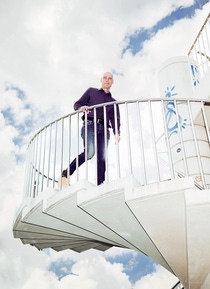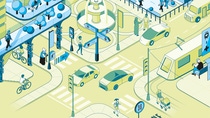Media
Sustainable mobility: is it on the horizon?
Everywhere and nowhere
Distant places and home. The desire for discovery and travel as a lifestyle. The risk of excessive travel contrasting with new ideas that fuel our personal journey. Are we getting carried away with mobility? A conversation with Stefan Gössling, Professor of Sustainable Tourism and Mobility at Linnaeus University in Sweden, about the risks and opportunities at the heart of a mobile society.
Key points at a glance:
-
The urge to explore the world is evolutionarily ingrained. An extreme form of this is hypermobility, which poses health risks, especially for frequent travelers.
-
Following the pandemic-related restrictions, there is a catch-up effect in travel behavior, which increases ecological burdens.
-
Moving away from private cars could improve the quality of life in cities and support a necessary shift in mobility.

Keeping the next destination in sight
Without humanity’s innate urge to explore distant places, the earth would not have been colonized, Marco Polo and James Cook would never have embarked on their expeditions, and humankind would not have dreamed of venturing into space. So, is the desire to travel embedded in our genes?
As inherently mobile beings, we carry an evolutionary legacy in this regard. Our history is defined by a perpetual search for new habitats. Nowadays, though, our motivation for being on the move is usually slightly different. For travel, the key segment is 3S tourism (short for “sun, sand and sea”), as relaxation is a key goal for most people. Sport is another central motive, with ski tourism drawing millions of people to winter resorts every year. Social reasons, such as spending time with family or meeting new people, can also play a role.
Is it this constant pull between a settled lifestyle based on routine and the desire to break free and be different that drives people out into the world?
Basically, yes. Travel also means reflecting on the place where you live, for example in terms of nature and culture. But I also see a growing desire to escape from everyday life. We are more driven now than we were 20 years ago. Trips are shorter, we check a destination off the list. It has become almost a requirement for young people to take a “gap year” when they finish school, and the aim seems to be to get as far away as possible; Australia and New Zealand are very popular. And, of course, status considerations also play a role in the choice of destination. You travel to show that you’re an interesting person. In a study dating from 2016, we showed how social media has made these motives even more important.

Less is more: When mobility becomes a burden
There are also people who don’t travel by choice but have to be mobile for professional reasons. You have used the term “hypermobility” to point out that society tends to glamorize frequent travel while ignoring its downsides. What are these downsides and what are their consequences?
People who are constantly on the move are exposed to various health risks, including jet lag and disorientation, upheavals in family life, and often also the impact of poor nutrition and a lack of exercise. This is especially problematic for business travelers. A sleep researcher once compared jet lag to being drunk, with all the implications for one’s work, which I thought was particularly apt. But I also remember the story of a business traveler who found his family growing increasingly distant – until his marriage failed. Young employees are often persuaded that having to travel is a desirable lifestyle, while older employees understand the consequences but find it difficult to escape the constant traveling required as part of their management role. During the pandemic, we saw just how unnecessary many business trips actually are. The economy kept going – even without air travel.
The covid-19 pandemic drastically limited the freedom of billions of people to move about. Did this have an impact on mobility behavior?
No, and we are certainly seeing a rebound effect now, with people traveling even more than before. Everyone seems to feel that they need to catch up. At the same time, the pandemic was important for showing us just how much air travel exacerbates global warming. Emissions dropped by about six percent during the pandemic, mainly due to the lack of air traffic. To stabilize global warming, we would need a six percent reduction in emissions every year, which is something I very much doubt we will manage. Given these circumstances, we should brace for the age of non-tourism to begin in the next 10 to 15 years. Due to climate change, more and more countries will no longer be viable travel destinations – either because of extreme weather events or the lack of social, economic and political stability in many parts of the world.
The age of non-tourism will begin in 10 to 15 years.“

The high cost of modern mobility
These scenarios give new meaning to the cost of mobility. We all know that the true cost is much higher than what we pay for airline tickets or gasoline. But how could these costs be factored in?
Most people think they are being fleeced when they buy a car and are required to pay taxes and fees. In reality, car ownership in a country like Germany is commonly subsidized by more than 5,000 euros per year – partly because the cost of climate change is not factored in. This applies even more to air travel, a sector that could not survive without subsidies. Currently, such costs are being carried by the general public.
Can you explain that?
Over the past 40 years, airlines have made an average profit of around 80 cents per passenger – and only because air travel is subsidized. There is no country in the world that charges VAT on international flights; you don’t have to pay for the climate damage you cause, the government subsidizes many airports that do not make a profit. In countries like Germany, there is something of a carbon tax, but it would have to be about ten times higher to cover the estimated minimum cost of the damage caused by emissions. This is an undisputed scientific fact. At EU level, efforts are being made to reduce emissions, and the Green Deal aims to make Europe climate-neutral by 2050. But so far, things are not happening fast enough and there are too many exceptions.

What will the transportation of tomorrow look like?
Cars, i.e. private transportation, are slowly being pushed back and replaced in many cities by new forms of mobility, such as car sharing, e-scooters and soon maybe even robocopters. Is this progress or are we simply creating an excess of mobility options?
The key question is: Which modes of transportation are in fact useful? If we all took off in private helicopters, the airspace above the cities would get crowded – it doesn’t take much imagination to realize that. Many other things depend on how we choose to handle cars. We are at a crossroads: If we keep them, especially after they become autonomous, we will grow more and more reliant on them as they become increasingly convenient. But if we move away from private cars and clearly prioritize bikes, public transportation or individual mobility services, we make these modes of travel far more attractive – and at the same time free up urban spaces that could be repurposed. It has been shown that this would massively improve the quality of life in our cities.
It sounds like you aren’t entirely pessimistic about the future of mobility, despite the significant problems attached.
We can gain a lot from new mobility, especially in urban areas, but political institutions are ignoring the facts. All over the world, countries experiencing rising incomes and prosperity are following the development patterns of the industrialized nations, for instance in terms of car ownership. The West could develop a counter-model, but it isn’t doing so. We talk about transforming transportation, but we are not listening to the visionaries. How you get around, incidentally, is also a cultural issue: If you grew up with a car, you are likely to drive a car; if you grew up with a bike, you’ll probably ride a bike. It’s no coincidence that up to 60 percent of all trips in cities in the Netherlands are made by bike. So, it is possible to change. But that takes more than simply redesigning transportation infrastructure; you also have to educate and actively promote these changes to generate widespread public support.

STEFAN GÖSSLING
is a professor at the Faculty of Economics at the Universities of Kalmar and Lund in Sweden. His research fields are sustainable tourism, transport and mobility.



